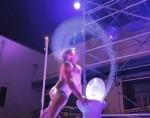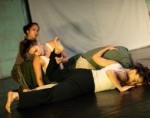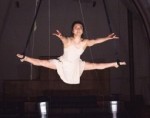
Interview with The Dance Apocalypse
by Karl Surkan
I arrive, somewhat breathlessly, after climbing up three flights of stairs to enter Aux Performance Space at Vox Populi, a gallery in downtown Philly on a Sunday afternoon. Nicole Bindler and Gabrielle Revlock, the choreographic duo calling themselves The Dance Apocalypse, are already there, getting ready to rehearse. We are talking about dance making, dance funding, and the creation of their new The Dance Apocalypse/Solos show, which runs November 13-15.“I need my wig.” Nicole Bindler shoots her collaborator Gabrielle Revlock a steely glare. “I gave it to you at the last rehearsal.”
“I don’t have your wig,” Revlock replies evenly.
“You took it last time,” Bindler insists.
Unfazed, Revlock rummages in her bag, pulling out a mousy brown wig in a Ziploc. “This is my wig.”
“Are you sure you didn’t take it? I remember that you did.”
“I don’t have your wig. I don’t have it.”
Bindler pauses, considering. “Maybe I forgot it at home. Can I borrow your wig then? Just for the beginning.”
Revlock throws up her hands as she hands it over. “This isn’t part of it,” she tells me.
Perhaps not, but it could be a scene right out of Chicken Fight, their proposed feature-length narrative film project “with dance sensibilities” now re-imagined as a web series. All that exists of it so far is a six-minute trailer, used in a failed million-dollar Kickstarter in 2014 and now part of the Solos show.
Like everything else about The Dance Apocalypse, it’s hilarious and manages to be outrageous, provocative, and intimate all at once. “We wanted to make a film that would pass the “Bechdel test,” Revlock explains, “in which two women can have a meaningful conversation that isn’t about a man.”
A million dollar fundraiser. A film with dance sensibilities. Audience participation in a clitoral embodiment class. Q & A sessions embedded in their performance. A solo, performed naked. Humor. Irony. Monstrosity. Apologies. Commentary on the state of dance performance and dance funding. The Dance Apocalypse/Solos is all of these things and more. With reactions ranging from approving to perplexed to bewildered, some critics don’t know what to make of The Dance Apocalypse, and often wonder, is this for real, or just clever meta-analysis? Who would donate a million dollars to an experimental dance production?
Precisely the point, Bindler and Revlock would say, and they’ll take the risk of making it. Interviewing The Dance Apocalypse is a bit like encountering an old married couple – they interrupt each other, finish each other’s sentences, all with a remarkable intensity and enthusiasm for each other and a love of the work they are creating together. Improvisation is central to Bindler and Revlock’s process and it has become such second-nature to them that even their conversation feels performative.
Bindler and Revlock began collaborating in 2011, on I made this for you, a critique of The A.W.A.R.D. Show. Bindler describes the competition, sponsored by the Joyce Theater Foundation, as “a total farce” for its rules requiring dancers from completely different genres to compete against each other. Since “we thought [it] was totally ridiculous, we decided to do that within our piece,” she explains. They engaged a cast of 20 plus dancers of different genres: jugglers, twins, martial artists, hip hop dancers, acrobats. The result was dubbed a “dance apocalypse” in a panel discussion, and the name stuck.
Solos is a theatrical piece in two parts, The Dance Apocalypse/Fundraiser, performed by Revlock, and The Dance Apocalypse/Class, performed by Bindler. Both sections work to challenge the concept of performance and the traditional role of the audience by carrying elements of their (real) fundraiser and Bindler’s (real) somatic movement class on clitoral embodiment into the performance space. So Revlock is actually asking audience members for money, and Bindler is leading the audience in an excerpt of the class in performance.
The Solos show is a retooling of a work-in-progress duet initially supported by a Pew Center for Arts & Heritage planning grant. Ironically, says Revlock, “the work-in-progress was way more complicated than what is in some ways the finalized piece. We had to scale back everything.” What remains is fresh and biting commentary on the state of dance funding, and an educational challenge to participants to rethink their relationship to their own genitalia outside the gender binary.
Audiences can expect an unconventional show, one that ultimately blurs the line between fundraiser, class, and performance. “This is one of the complicated elements of the piece,” says Revlock, when I ask about how the audience understands the class participation in Solos. The stakes and engagement are different, Bindler explains: “In the real class, people are paying money to do a class; in the performance, people are just put into a class situation.”
“And it’s the part I find people are the most emotional about,” Bindler adds. “Some people told me, ‘wow – that was one of the most empowering and freeing experiences of my life,’ while I’ve had other people storm out.”
Both solos have the potential to take audience members out of their comfort zone. Revlock believes the problem is parsing out meaning from the context. “As soon as we’re in the performance space, people are already assuming performance, but then when they hear us using our own names, when they hear other contexts they assume a certain amount of reality, and we tend to kind of bounce around in that space. It can make it feel very alive, and it can also make some people feel really anxious or confused, “ she says.
Bindler’s solo invites the audience to participate as students in a pelvic floor exercise, designed to get people to think about their genitals as sexed organs that developed from a single ungendered anatomical origin, the embryonic precursor to the clitoris or the penis. Not everyone is on board. They fault the lack of engagement and participation in the class element with a recent negative review by a male New York Times reporter.
“He had an identity that he was holding onto when he came into the performance, which was ‘I’m reviewing this, I’m the writer,’” explains Revlock.
“So he never dropped into his body in the class part,” Bindler adds.
“Right – so he only viewed the entire thing as a performance. I think he wasn’t able to fluctuate.”
“Or find his clitoris.”
“And that’s the real problem,” Revlock says through her laughter.
The duo want audiences to know that they have thought deeply about what they are asking onlookers to do, and aim to make it safe for them to fully participate. “I think it’s been said that it’s scary for some audiences; it makes me think of the circus, where the clown chooses somebody from the audience and then makes them sit on a chair on stage,” says Revlock.
“People can trust that we’re the clowns, and we’re each other’s victims,” Bindler assures me.
Revlock nods. “They can really feel like ‘what if – should I or shouldn’t I? Could this happen?’ But we’re in control, everybody. We won’t make you do anything you don’t want to do.”
The Dance Apocalypse/Solos, Aux Performance Space at Vox Populi, November 13-15, 7pm. http://thedanceapocalypse.org
By Karl Surkan
November 12, 2015






.png)


